A Staged Farewell
Nellie Stewart's treasured gift from a special evening
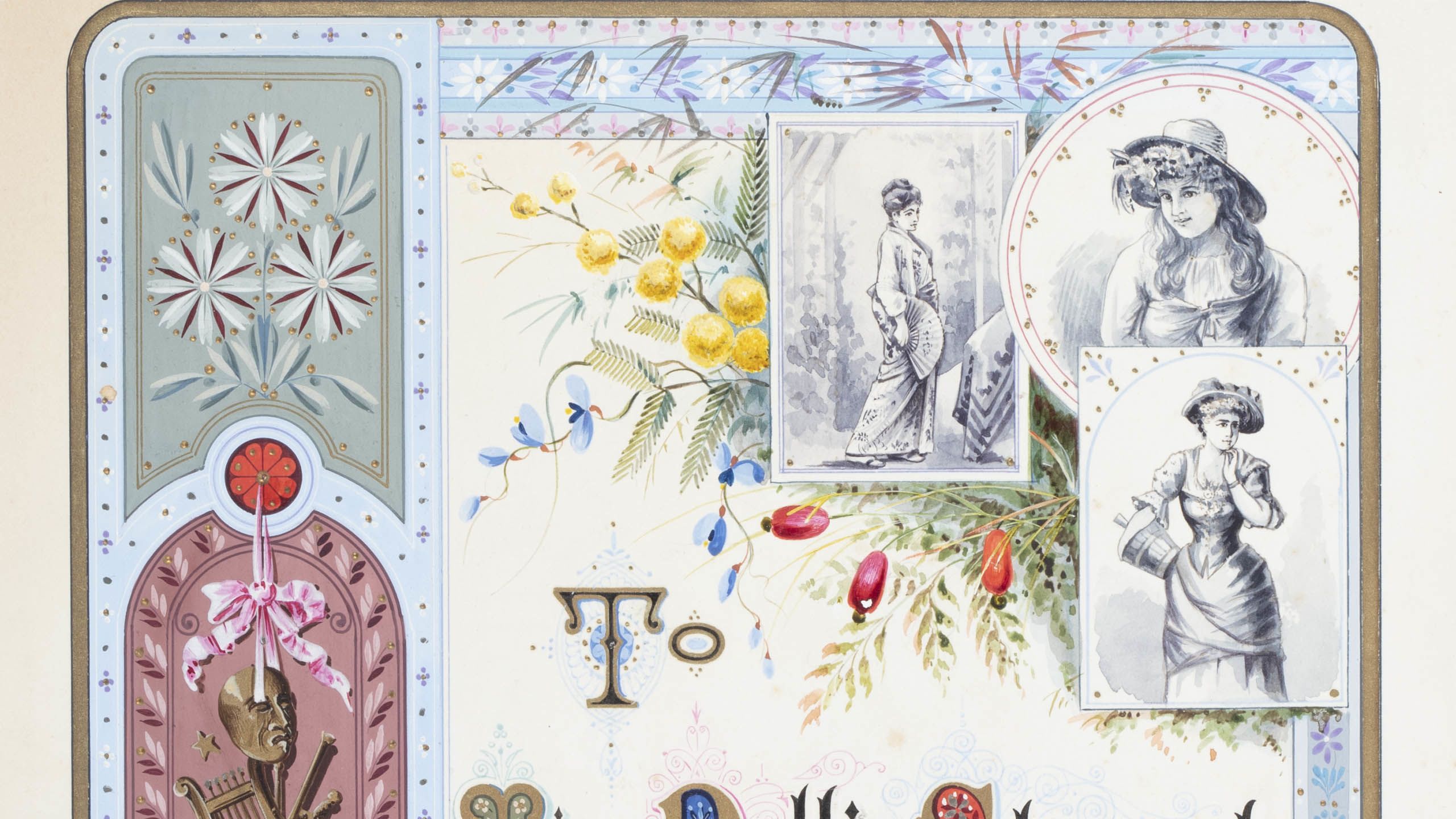
On a summer evening in February 1887, the audience at Melbourne’s Princess Theatre witnessed a special event. Popular young star, Miss Nellie Stewart, was taking 12 months break from the stage and this was her extravagant farewell.
At the end of the first act of The Mikado, Stewart was honoured with words of praise, floral bouquets and generous gifts. Among the items she received was a hand-decorated tribute bound in a brown leather cover.
Treasured for many decades by Stewart and her descendants, it is now part of the Australian Performing Arts Collection. Curator Margaret Marshall uncovers the stories behind this fascinating object and the public event that concealed a secret affair.
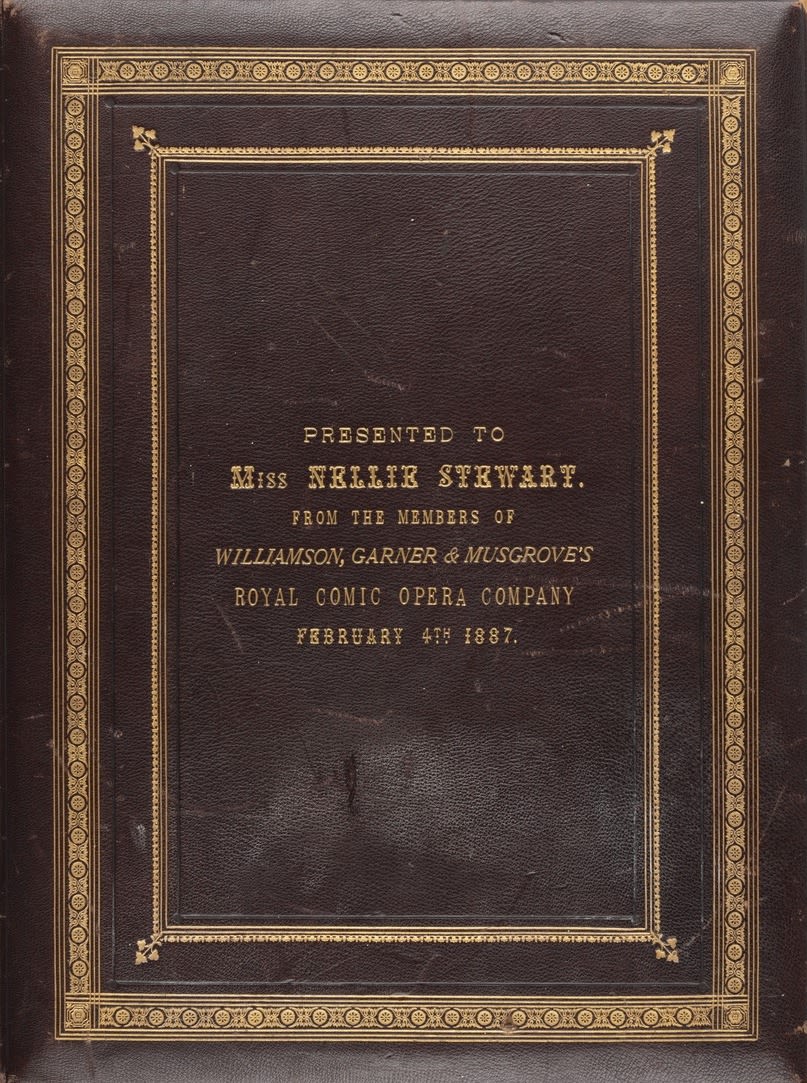
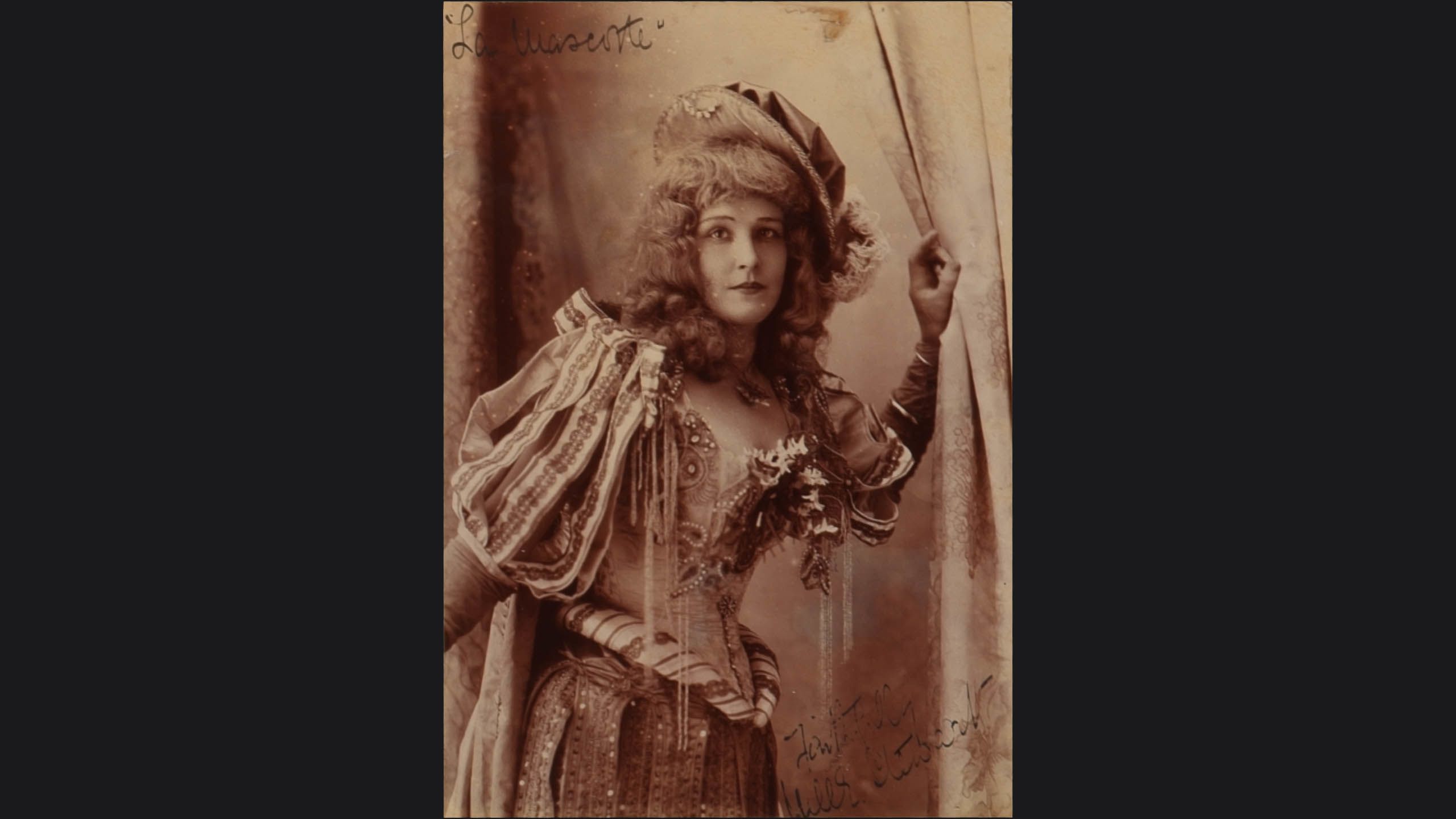
Nellie Stewart as Bettina in La Mascotte, 1890
Nellie Stewart as Bettina in La Mascotte, 1890
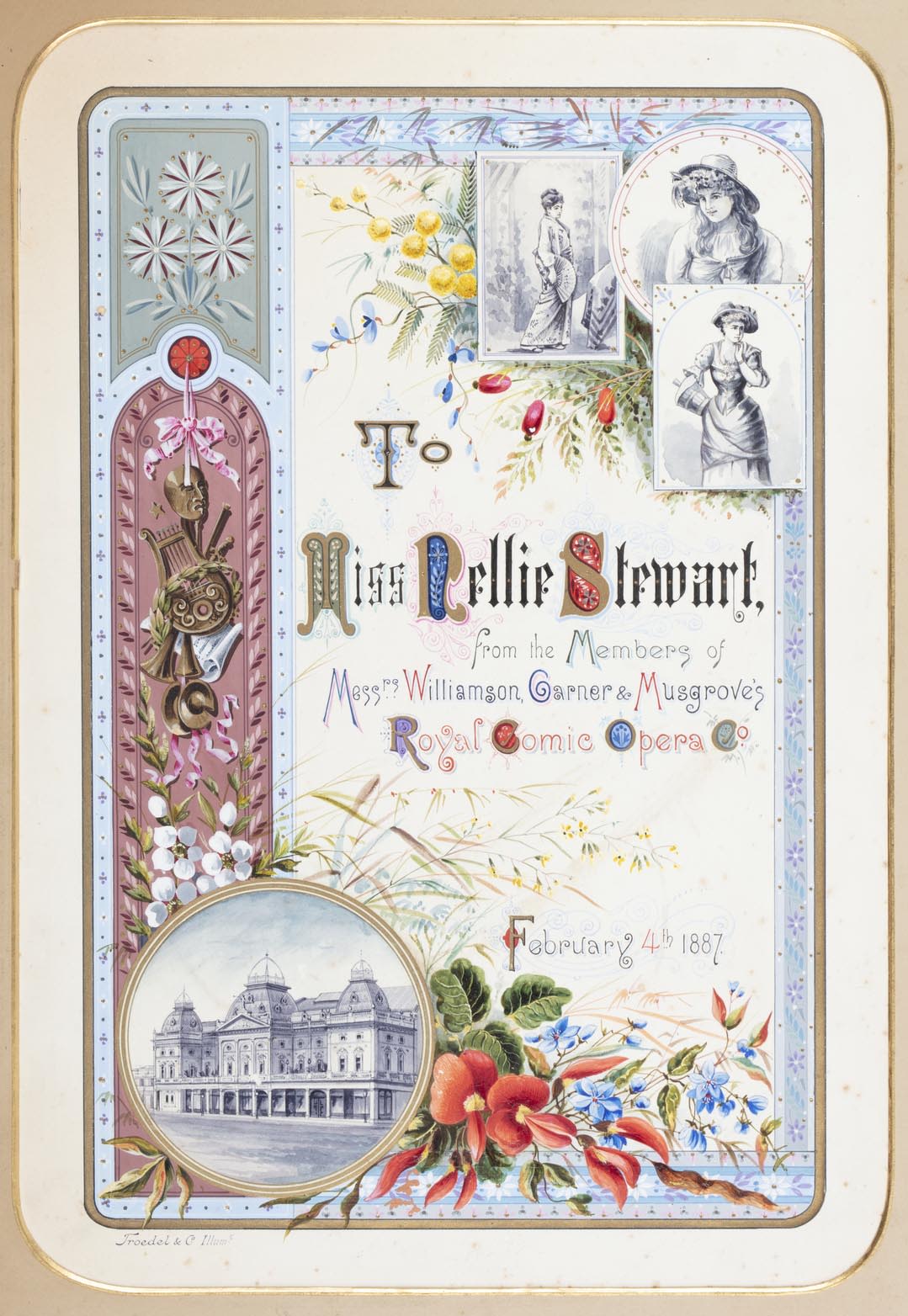
Rising Star
Nellie Stewart was one of the most beloved Australian theatre performers of her time. Known for her beauty and talent, she starred in musicals and pantomimes, light opera and drama. She was a contemporary of another Australian ‘Nellie’ – the internationally renowned opera singer Dame Nellie Melba.
Born into a theatrical family in Sydney in 1858, Nellie Stewart began performing on stage at the age of five. She rose to prominence as a leading lady during the 1880s and remained a favourite performer throughout the following decades.
“Always I knew that I was fated to the theatre.”
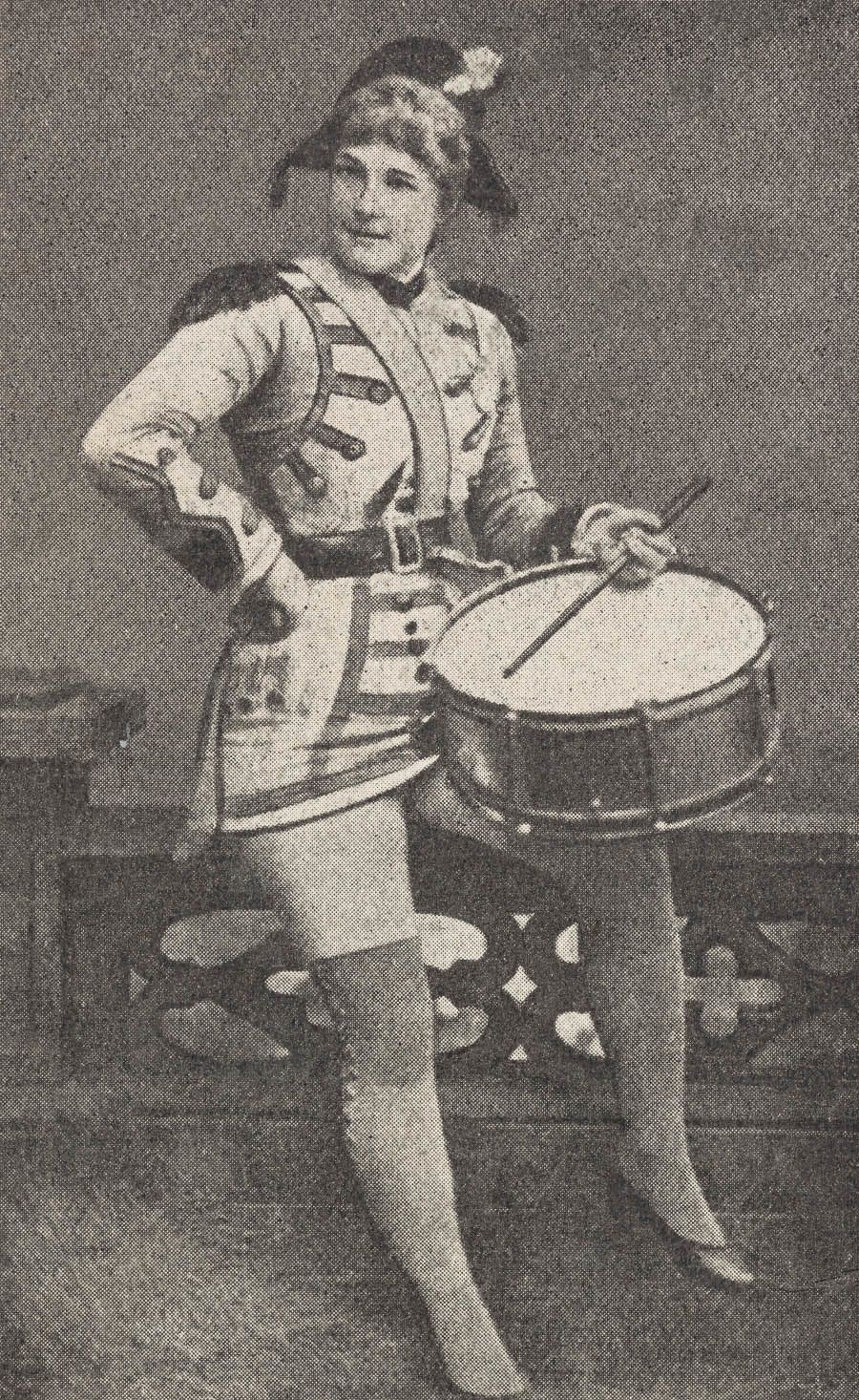
Nellie Stewart as Griolet in La Fille du Tambour-Major, 1881
Nellie Stewart as Griolet in La Fille du Tambour-Major, 1881
Stewart’s first major success was in the 1880 pantomime Sinbad the Sailor in Melbourne. She was noticed by a young theatrical entrepreneur, George Musgrove, who offered her the lead role in the operetta La Fille du Tambour-Major when the headline performer withdrew prior to the Adelaide and Sydney seasons.
In 1882, Musgrove went into partnership with James Cassius Williamson and Arthur Garner, both former actors who had moved into the business side of theatre. Together these three men formed a powerful management that became known as ‘the triumvirate’. At the time, Williamson was 38 years old, Garner was 31 and Musgrove just 28.
Nellie Stewart soon became a star of Williamson, Garner and Musgrove's Royal Comic Opera Company. This company staged popular operettas in cities across Australia and New Zealand. Their repertoire included works by W. S. Gilbert and Arthur Sullivan for which Williamson had astutely secured the Australasian performance rights.
Over a period of six years, Stewart performed principal roles in Patience, HMS Pinafore, Iolanthe, Princess Ida, The Yeomen of the Guard and The Mikado, as well as La Mascotte, Olivette and Les Cloches de Corneville.
“My understudies never had much luck. I was too keen.”
Then in November 1886, Stewart's intention to temporarily leave the company was announced. This must have come as a blow to the management but in true show business style they made the most of the situation. Stewart gave a farewell performance in Sydney, before bidding Melbourne audiences goodbye on 4 February 1887.
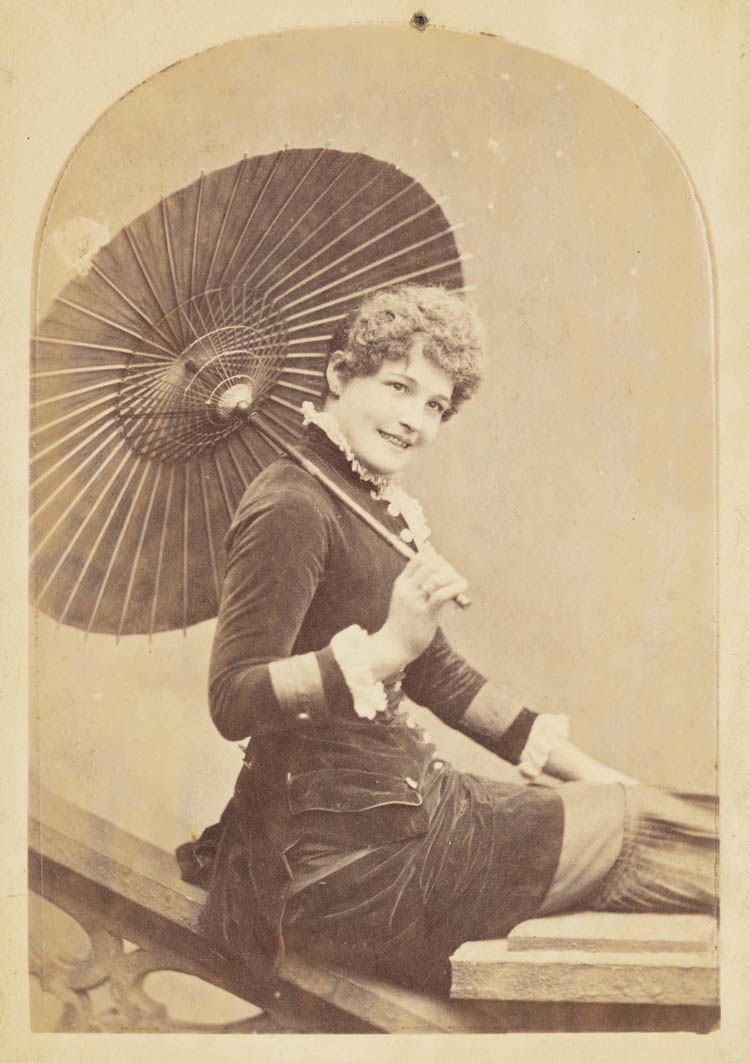
Nellie Stewart, 1881
Nellie Stewart, 1881
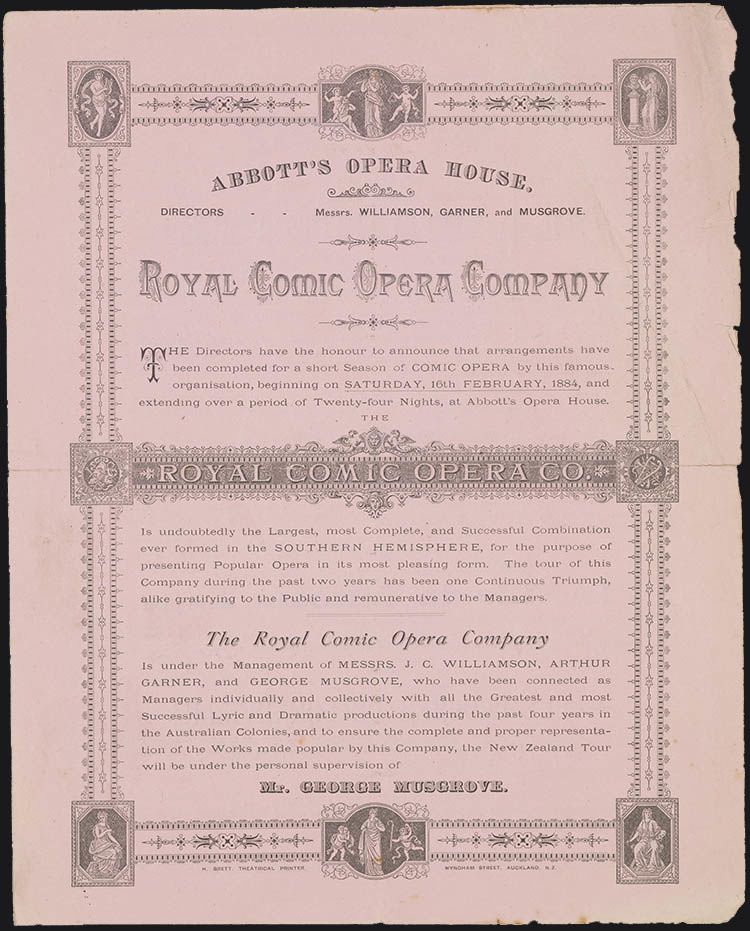
Brochure for the Royal Comic Opera Company, New Zealand tour, 1884
Brochure for the Royal Comic Opera Company, New Zealand tour, 1884
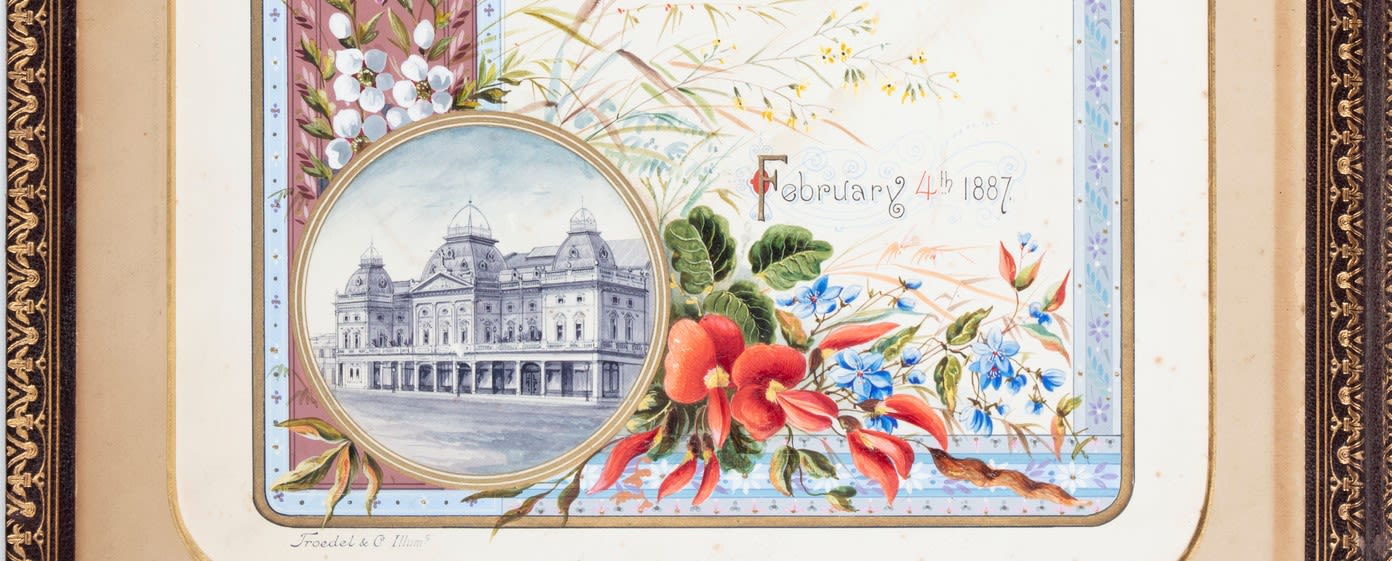
Farewell Benefit
Melbourne's chosen venue for Stewart's ‘grand complimentary farewell benefit’ was the recently re-built Princess Theatre on Spring Street. Williamson, Garner and Musgrove had commissioned leading Melbourne architect William Pitt Jnr to design a lavish venue in place of an older theatre on the site. The grand new structure reflected the wealth and confidence of the city's 1880s boom period.
The Princess Theatre opened just seven weeks before Stewart's farewell. This major civic achievement is proudly depicted, surrounded by Australian flora, on the opening page of her souvenir.
The production staged for Stewart's farewell was also a considered choice. In 1885 she had gained much praise as the female lead in the first Australian production of Gilbert and Sullivan's The Mikado. This operetta proved hugely popular at the time, although it reflected a stereotyped view of Japanese culture that is today considered offensive.
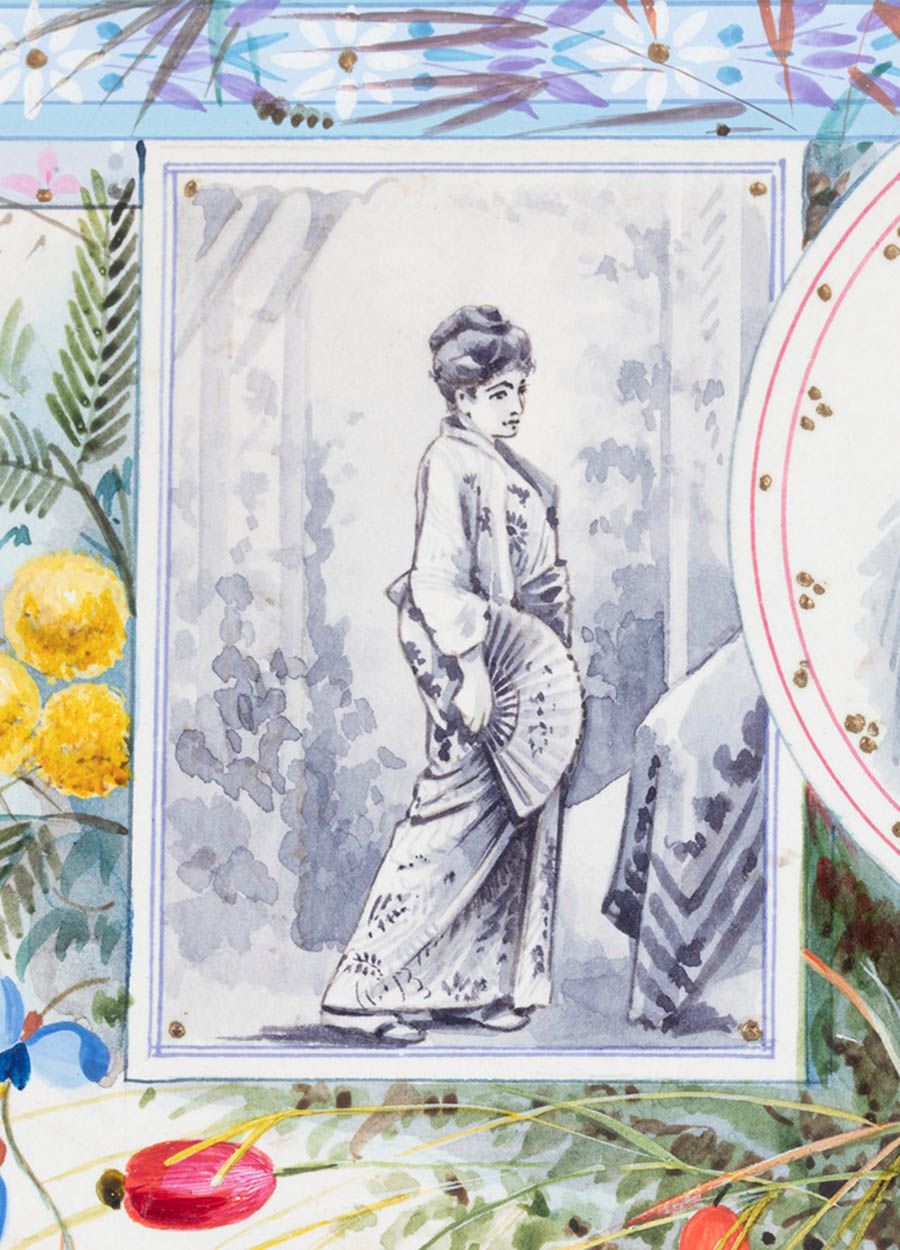
Detail depicting Nellie Stewart in The Mikado
Detail depicting Nellie Stewart in The Mikado, 1887
When the new Princess Theatre triumphantly opened Stewart had again been featured in The Mikado. Her success made it an ideal choice for her send off and Melbourne newspaper The Argus described it as "being the latest and the most adapted to her rapidly growing talent."
A programme printed in purple on silk was produced especially for the occasion – an extravagance reserved for opening nights and commemorative events.
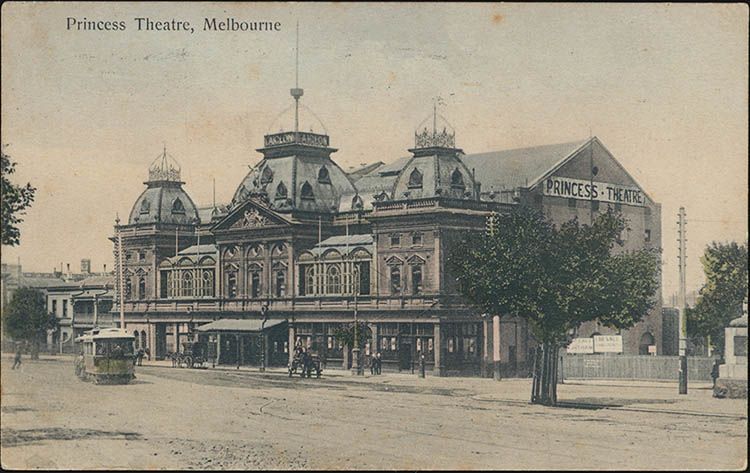
Princess Theatre, Melbourne, c.1907
Princess Theatre, Melbourne, c.1907
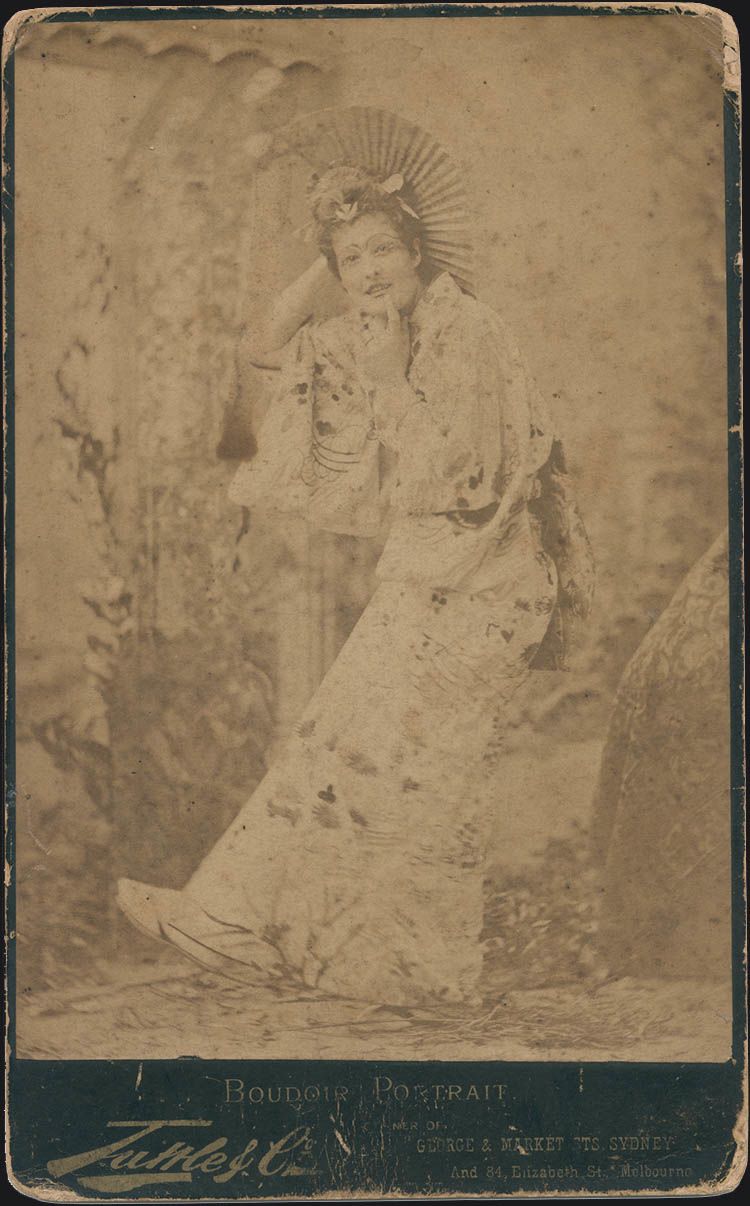
Nellie Stewart in The Mikado, 1885
Nellie Stewart in The Mikado, 1885
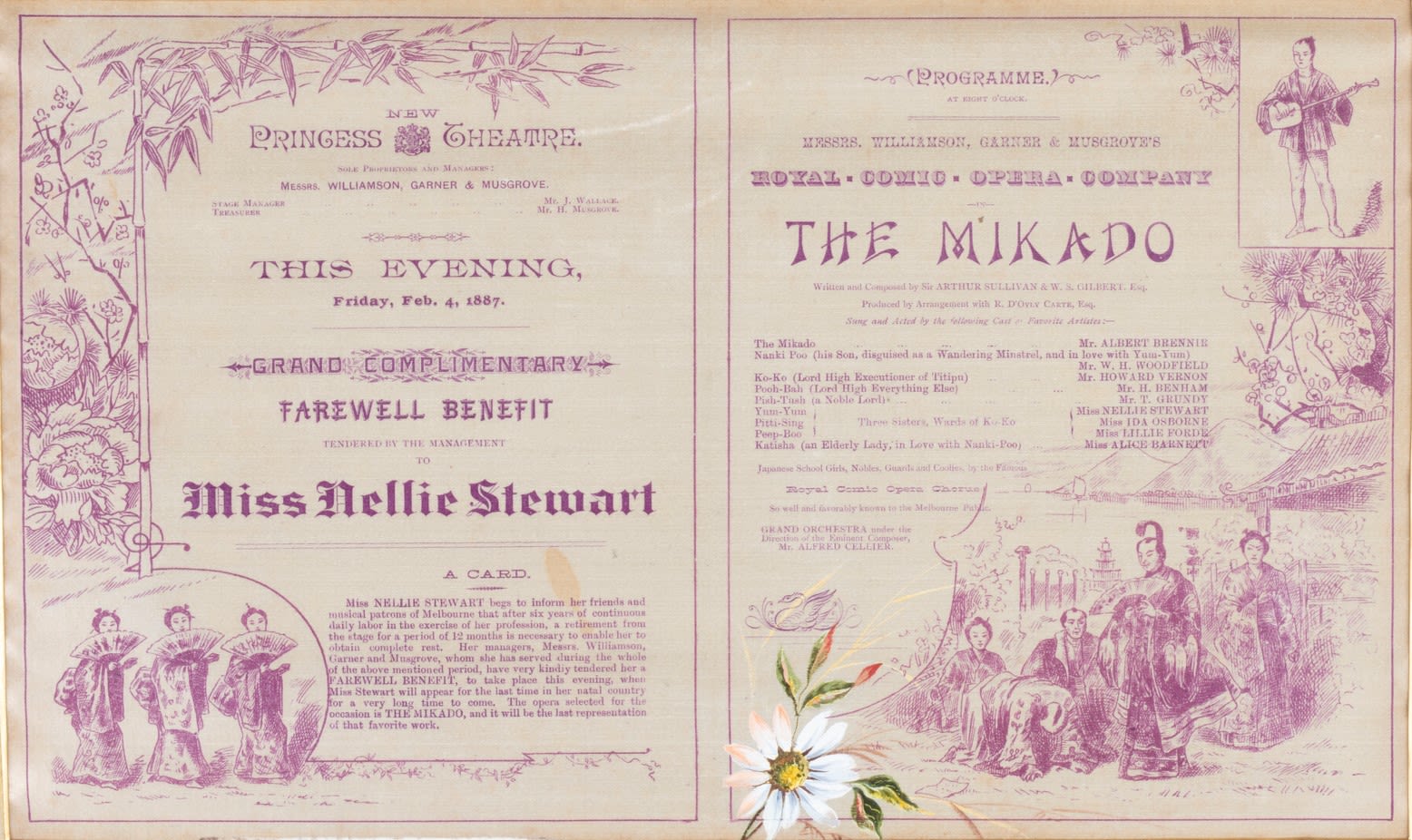
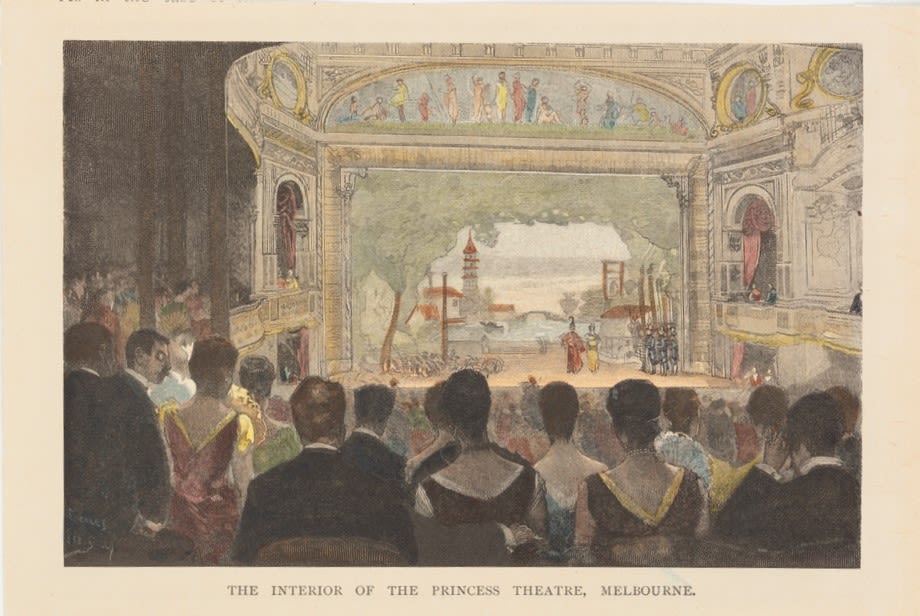
The night's proceedings were reported in newspapers the following day. The Argus noted that the theatre was filled “to its utmost seating capacity”. After the first act, Stewart was called in front of the curtain and heartily applauded.
A ceremony then took place which was the best part of the entertainment.
The curtain was raised to reveal the entire company assembled on stage. Fellow cast member Walter H. Woodfield read a tribute to Stewart from the bound volume.
These words, written by dramatist Garnet Walch, had been laid out in neat calligraphy. Praising Stewart's talents and noting key roles she had performed, the text also proudly highlights her as an Australian:
To you – Australian born – Australia points
With honest pride. In you Australians see
A darling sister – dowered with beauty rare
A thousand graces, and the gift of Song...
And now farewell! or rather, au revoir!
A prosperous voyage – a happy holiday
And then – come back! to find your place reserved
Choice seat – front row – amidst Australian hearts.
“There was an overwhelming house… and the memento was presented to me with due ceremony, amidst great enthusiasm.”
Stewart was also given a large diamond bracelet and a “pile of fine bouquets” from the members of the company. The Argus reported that the star of the evening “also received in her own room a beautiful ‘crescent' of diamonds and pearls, and a magnificent diamond bangle.”
On the final page of the souvenir is a handwritten list of 79 names – a record of Stewart's fellow company members. Many are the signatures of individuals, while others appear to have been written by the same hand.
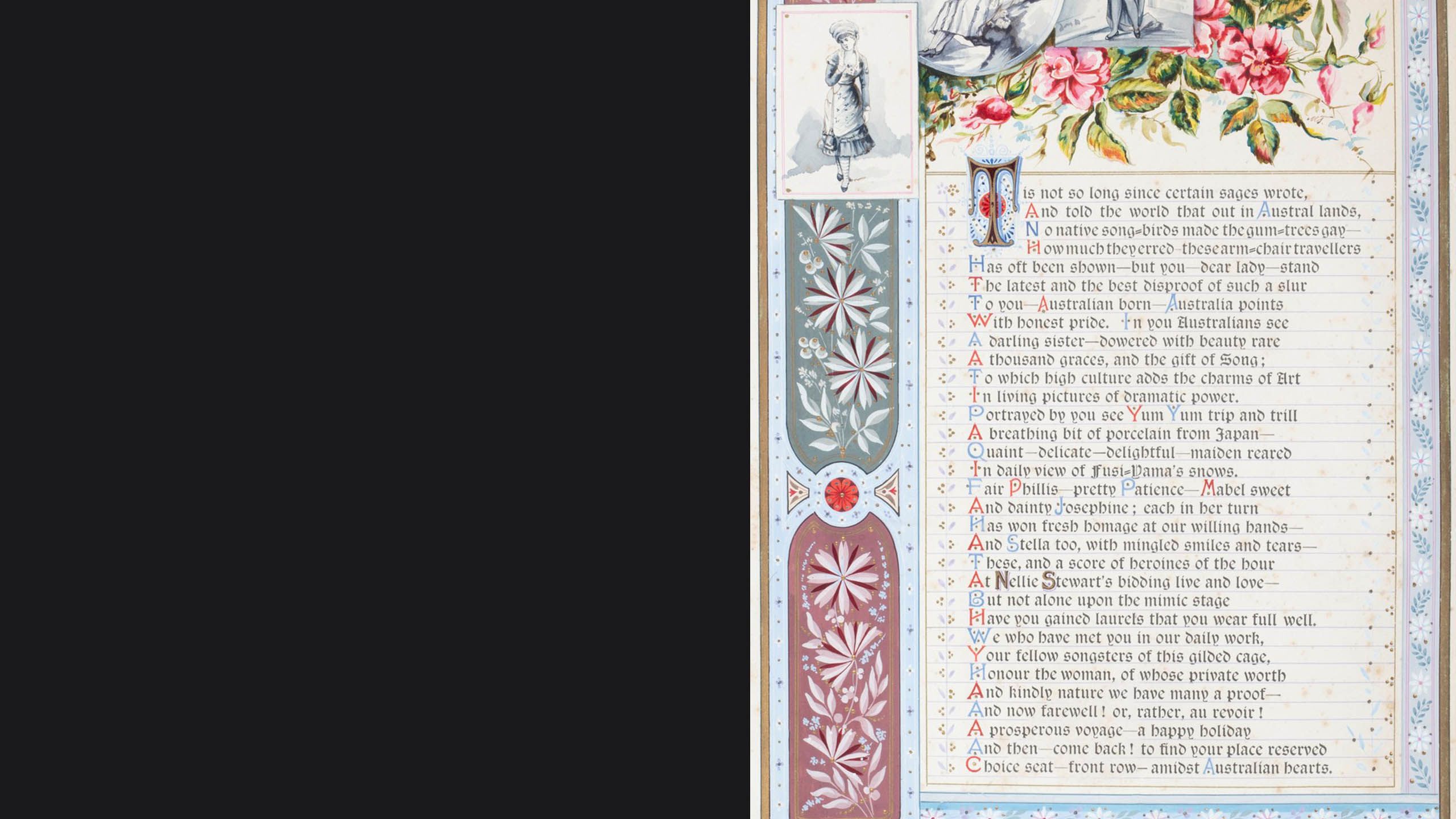
Several principal artists are listed in the first column including Alice Barnett, Ida Osborne, Howard Vernon and Albert Brennie.
Alfred Cellier was the conductor of the orchestra.
Those working behind the scenes also signed including the company's treasurer Harry Musgrove, and stage manager John Wallace.
Renowned scenic artist John Brunton added his name...
... as did young chorus member, May Pollard, who would later become a leading lady.
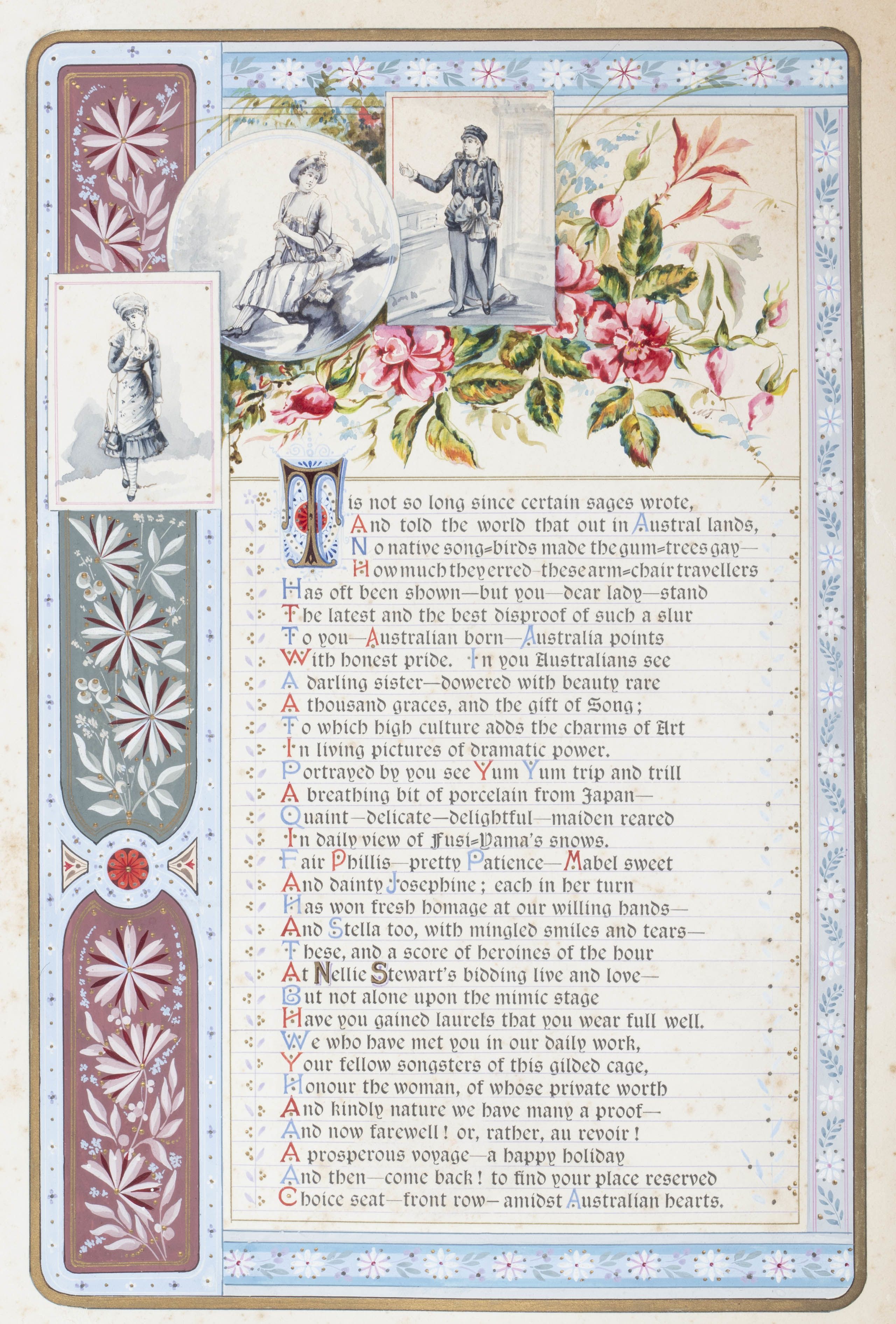
Public and Private
Nellie Stewart's departure from the stage was officially explained as being an opportunity for her to rest and travel after six years of continuous performance. A printed statement was even included on the silk programme.
In response to the onstage ceremony and gifts, Stewart made a speech expressing her heartfelt thanks and stating: “I am leaving the stage for 12 months for the sole reason that I need rest. During that period I propose to visit Europe … I do not intend to accept any engagement in England, should I be favoured with an offer, but I will hear and see and study hard, and endeavour to return more worthy of your kind encouragement.”
In her memoir more than 30 years later, Stewart wryly described benefit performances as being “part of the showman’s game”. She was referring to the distribution of profits but there was perhaps more to her statement. Behind the extravagant and heartfelt farewell was also a private motivation for Stewart's break from the stage.
Less than a week later, she and George Musgrove sailed to London. A published notice in The Australasian discreetly announced that they were passengers on the same ship. They were accompanied by Musgrove's mother and aunt.
By travelling together in this way the young couple publicly declared their personal relationship. What had started as a professional association was now a love affair spanning several years.
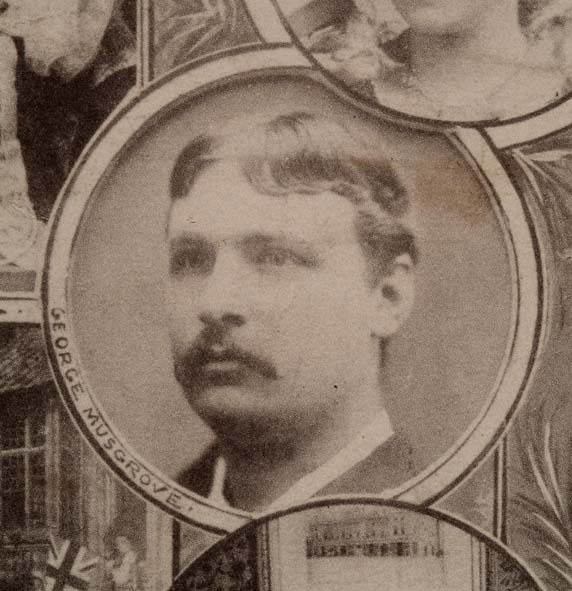
George Musgrove, c.1900
George Musgrove, c.1900
The relationship presumably raised eyebrows – Musgrove was already married and a father. Few people knew that Nellie Stewart had also wed in 1884. She had left her love-struck husband, Richard Goldsborough Row, after less than a fortnight and later described her marriage as “just a girl’s mad act to repent of at leisure afterwards”.
Ten months after their departure, Stewart and Musgrove returned to Australia in December 1887. While details of their private life were not disclosed, the couple's names were clearly linked in newspaper articles announcing their arrival.
This became one of the great romances of Australian theatre – a partnership that was to last 30 years. The couple's daughter, Nancye Stewart, was born in England in 1893. Stewart’s marriage legally ended in 1900 but as Musgrove’s wife would not grant him a divorce they were never able to marry.
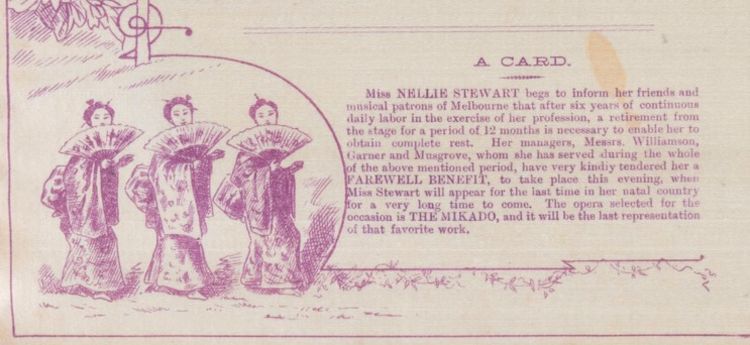
Detail of silk programme with printed statement
Detail of silk programme with printed statement
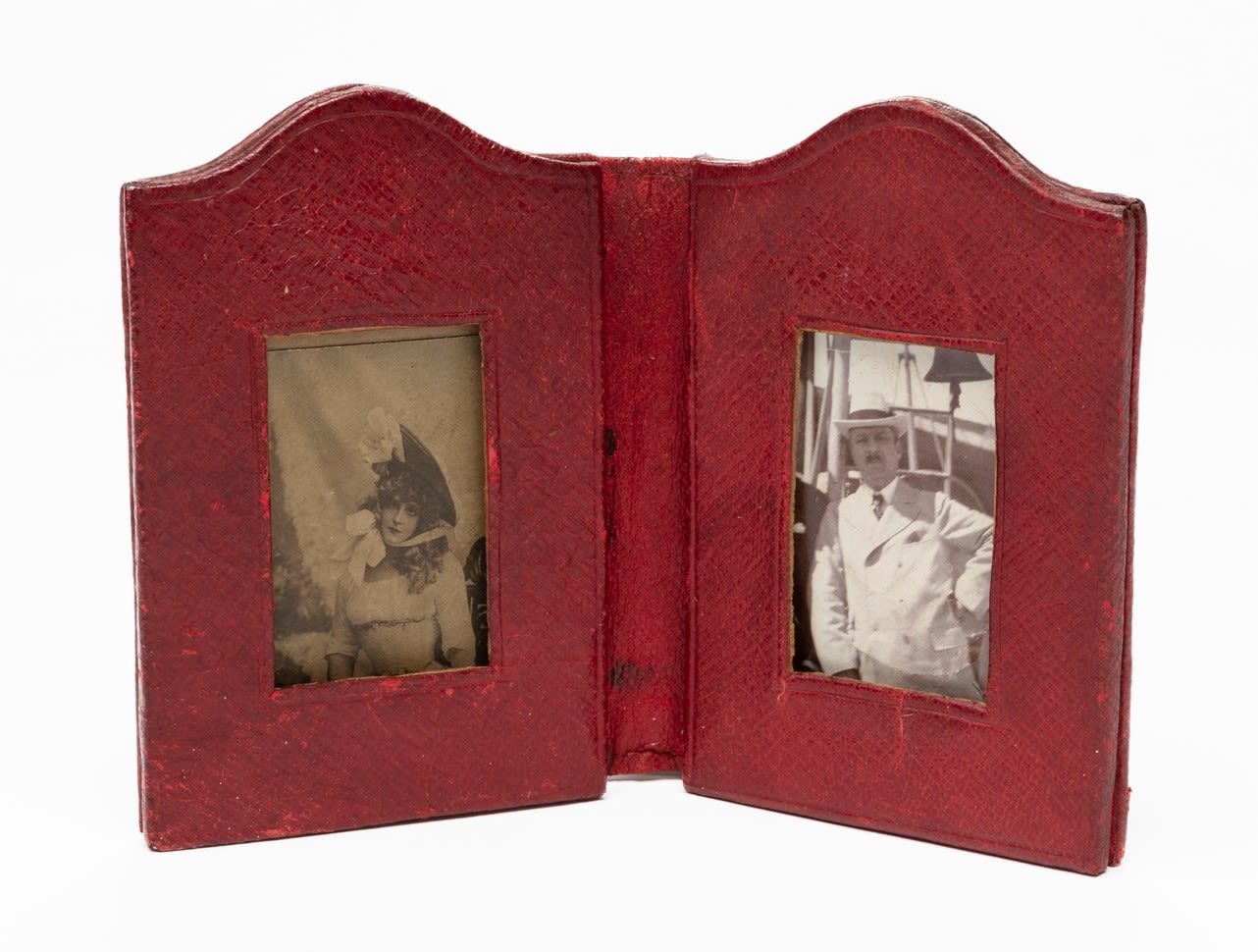
Leather frame owned by Nellie Stewart, containing photos of herself and George Musgrove, c.1895
Leather frame owned by Nellie Stewart, containing photos of herself and George Musgrove, c.1895
"George was my one and only consideration always ... as I was his."
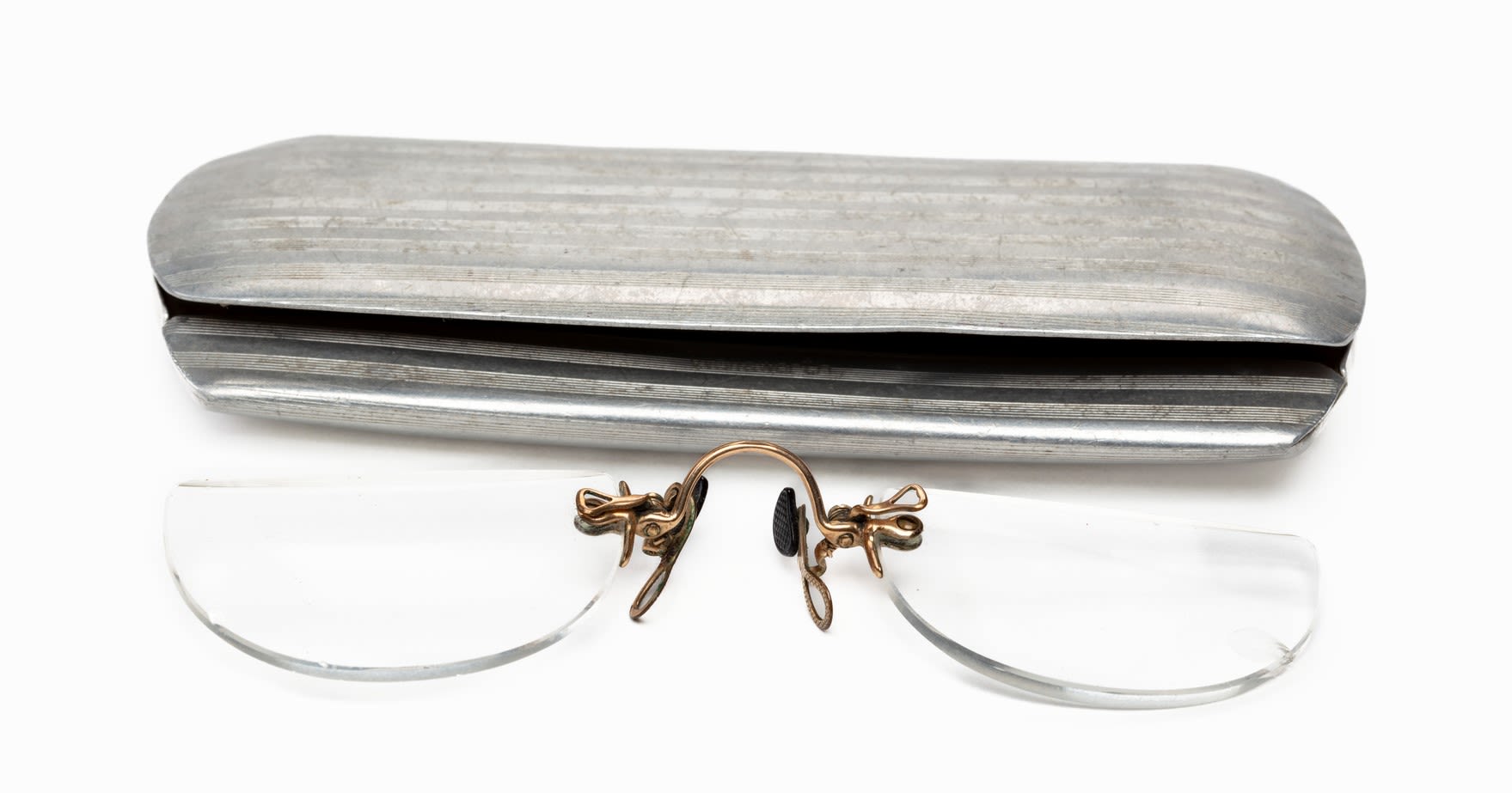
Pince-nez with metal case owned by George Musgrove, c.1905
Pince-nez with metal case owned by George Musgrove, c.1905
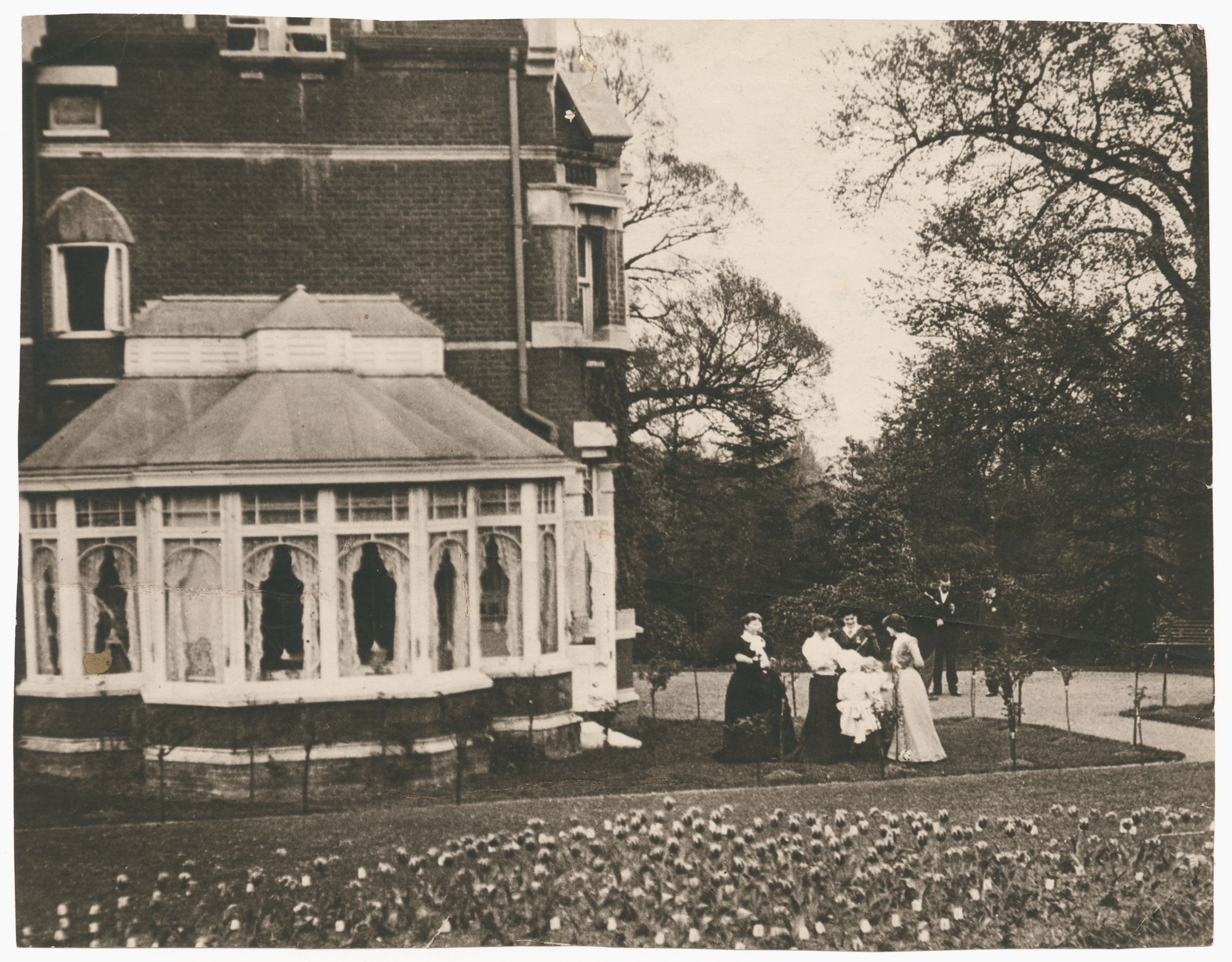
Nellie Stewart (fourth from left) and George Musgrove (right) at their home in England, 1899. This is the only known photograph of the couple together.
Nellie Stewart (fourth from left) and George Musgrove (right) at their home in England, 1899. This is the only known photograph of the couple together.
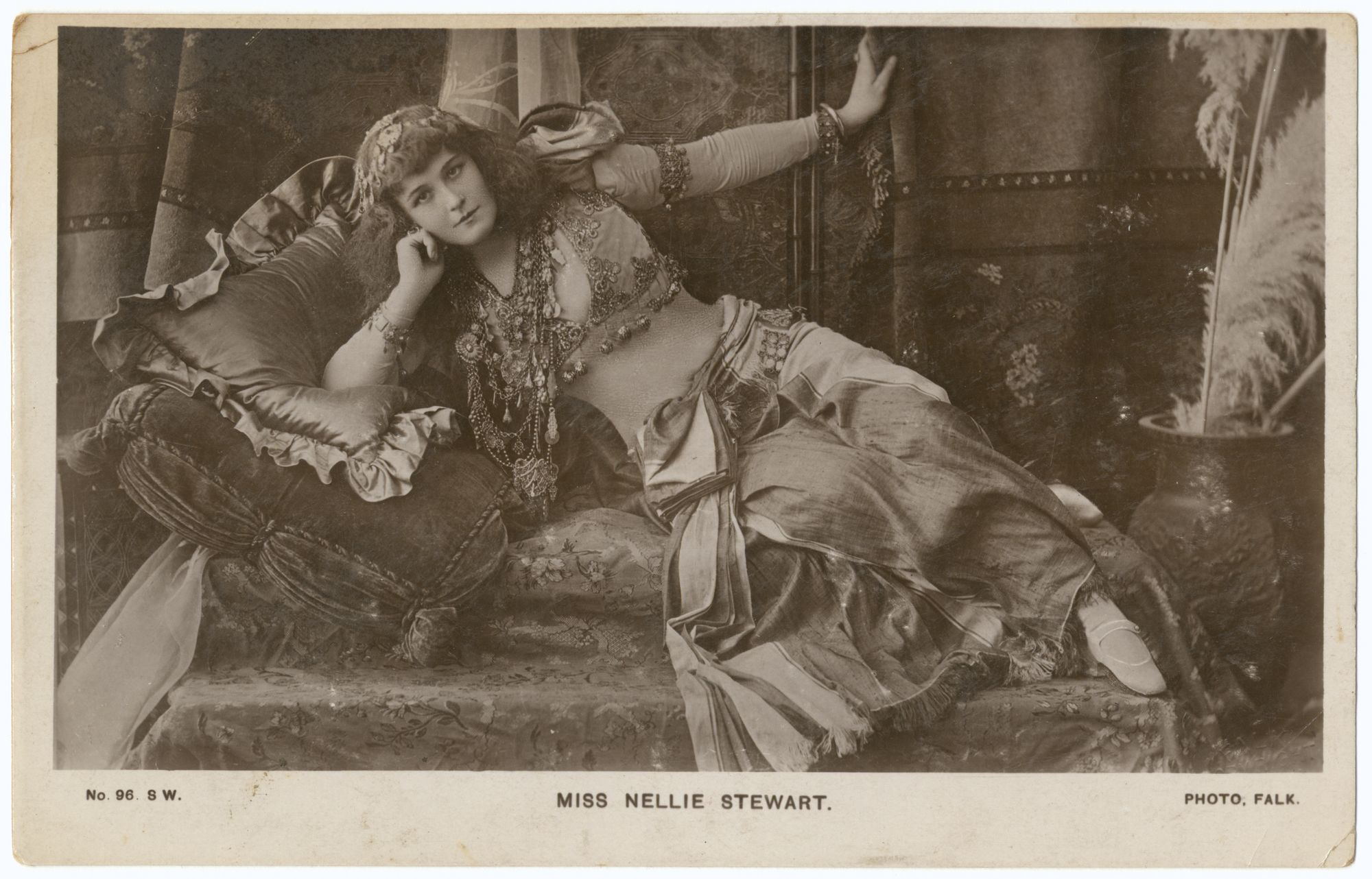
Australia's Darling
In March 1888, just three months after returning to Australia, Stewart again performed at the Princess Theatre. This time she took on the role of Marguerite in Faust, singing over 20 consecutive performances.
Over the next two decades, Stewart consolidated her place as a favoured Australian performer. Behind the scenes, Musgrove continued as an entrepreneur and actively showcased her talents.
Stewart entertained audiences in lavish pantomimes, popular musicals and dramatic plays. Her most famous role was Nell Gwynne in Sweet Nell of Old Drury – a play that became synonymous with her name.
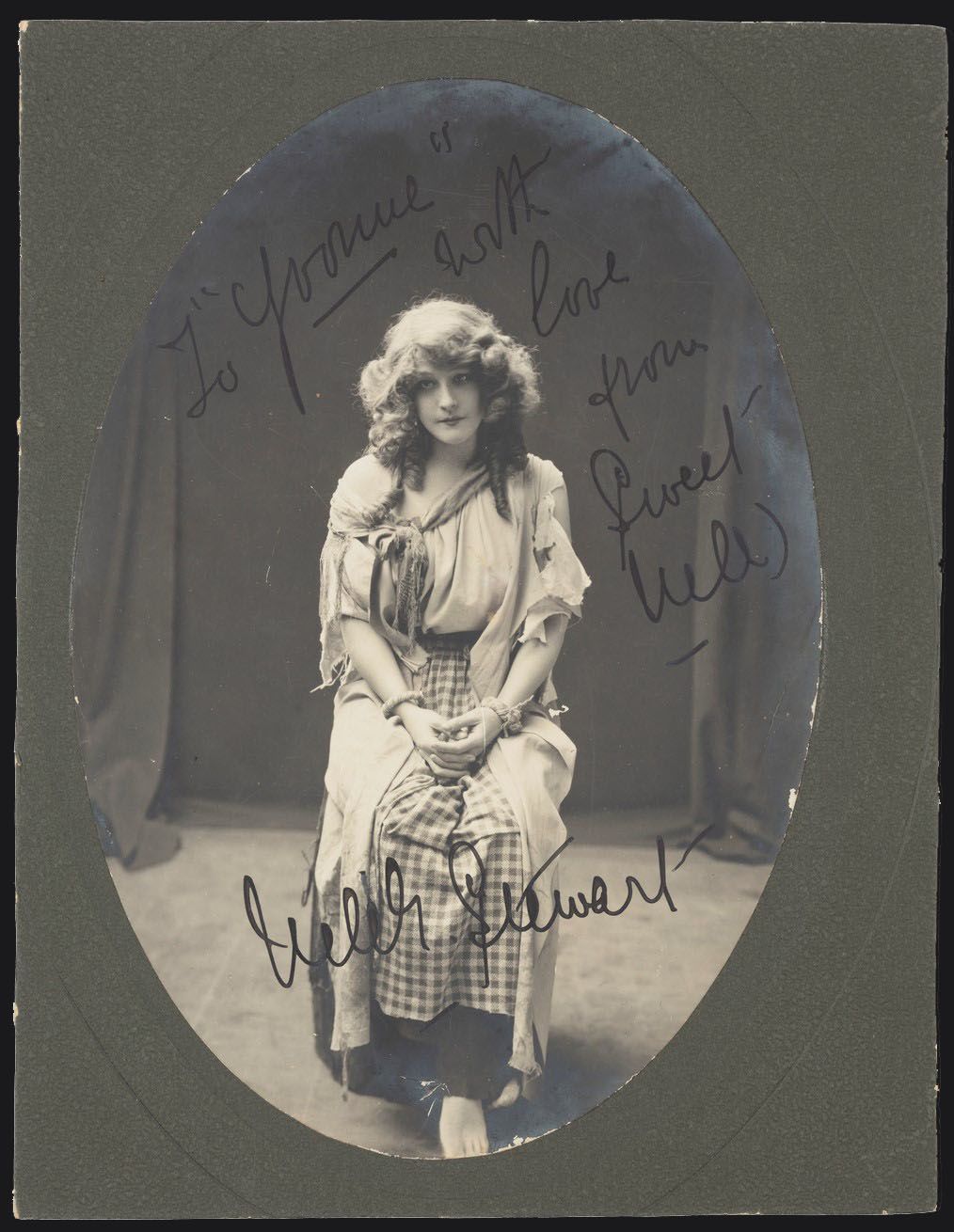
Nellie Stewart as Nell Gwynne in Sweet Nell of Old Drury, c.1907
Nellie Stewart as Nell Gwynne in Sweet Nell of Old Drury, c.1907
She also performed in England and the United States, but remained much-loved in Australia. Stewart's celebrity extended beyond the stage. Her stylish outfits were often detailed in the press, and fans avidly collected postcards and photographs featuring her image.
Her plain gold bracelet, a gift from Musgrove, began a widespread fashion craze. Known as the ‘Nellie Stewart’ bangle, look-alike versions were produced in varying sizes and qualities, and women across Australia adopted the trend for decades.
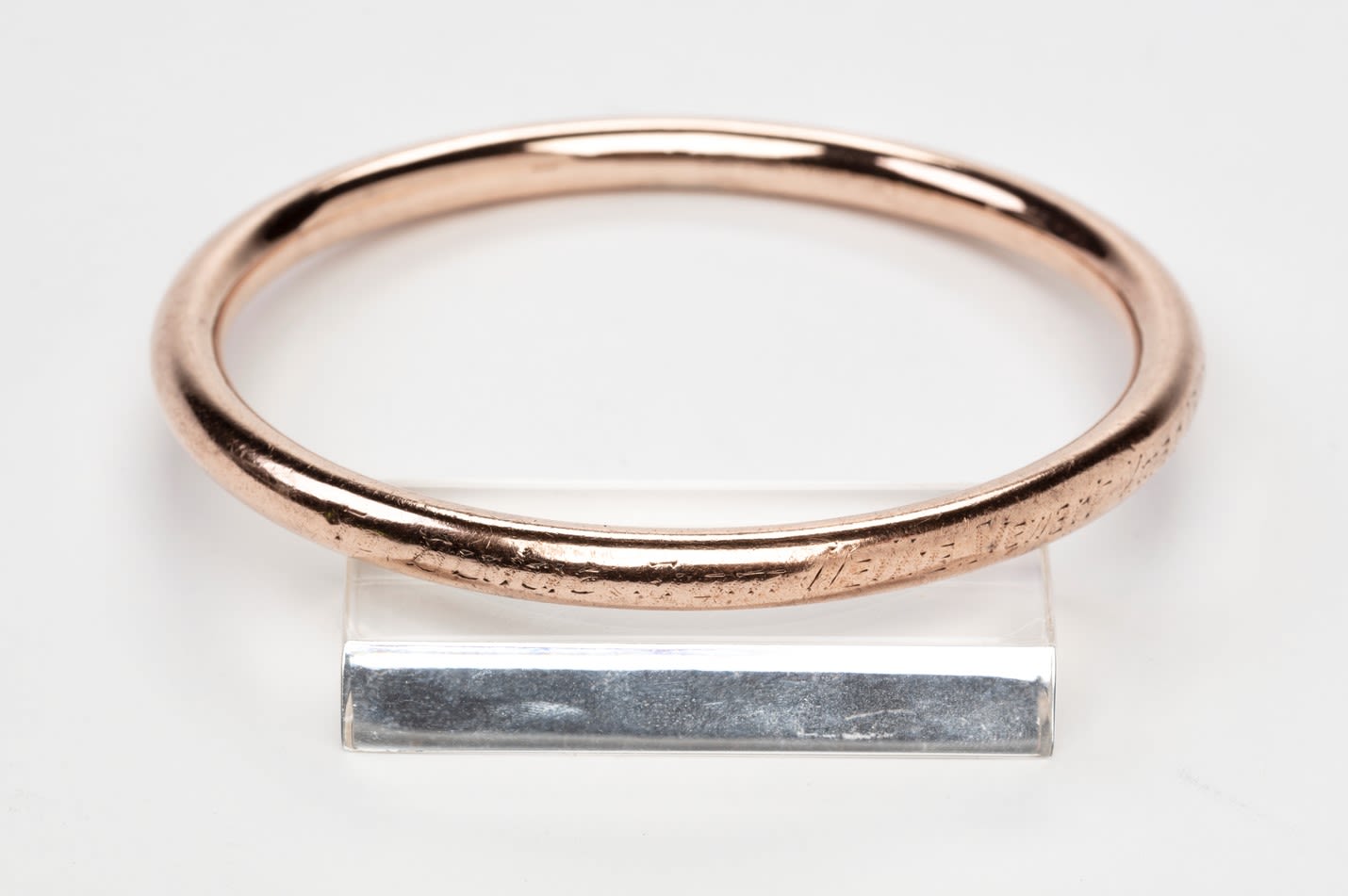
'Nellie Stewart' style bangle. Engraved: 'To Dulcie from Nellie Stewart Xmas 1930'
'Nellie Stewart' style bangle. Engraved: 'To Dulcie from Nellie Stewart Xmas 1930'
Over a century after Stewart's 1887 farewell evening, her bound tribute was entrusted to the Australian Performing Arts Collection by her grandson Michael Lynton. He subsequently donated many other items relating to his family including costume pieces, photographs and archival material.
At the centre of the collection remains this cherished keepsake documenting a moment in time and Nellie Stewart's significant role in Australian performing arts history.
We look forward to sharing this and other special items from the Australian Performing Arts Collection in our new research, storage and education facility opening later in 2023.
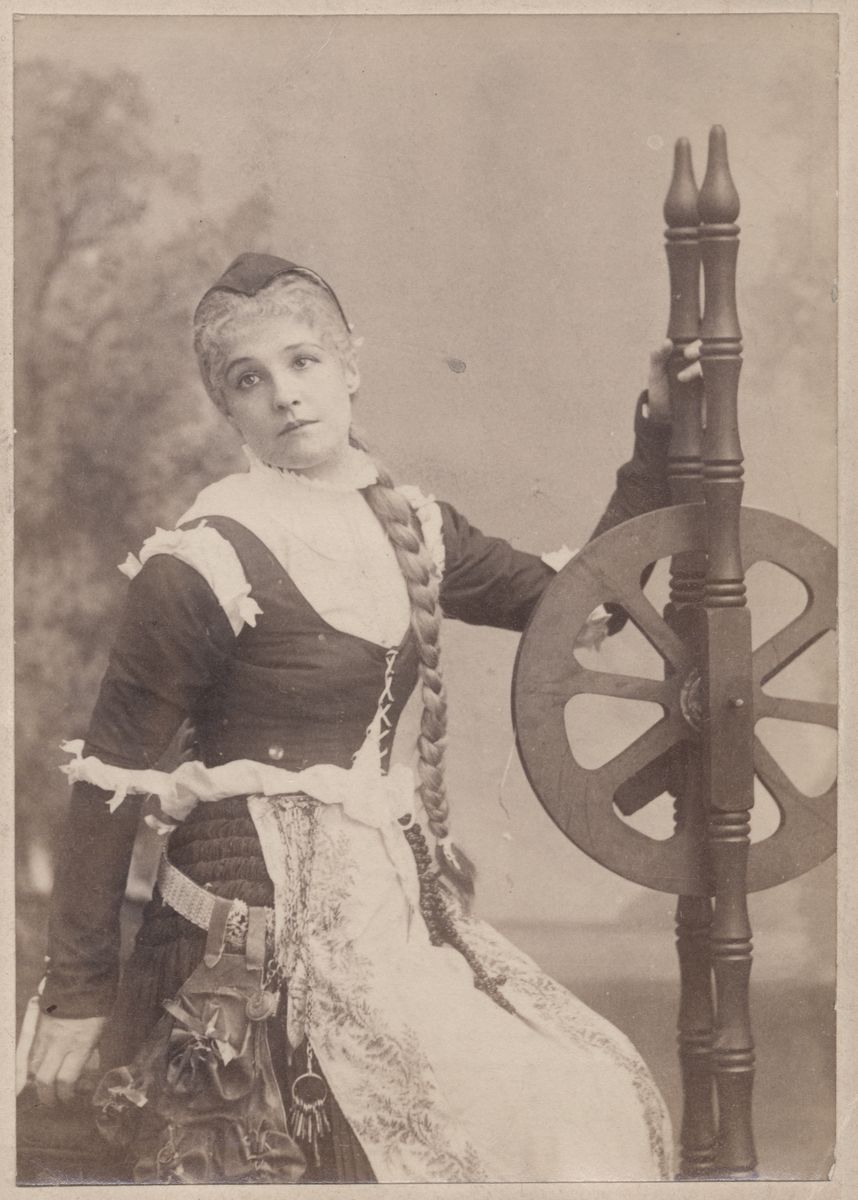
Nellie Stewart as Marguerite in Faust, 1888
Nellie Stewart as Marguerite in Faust, 1888
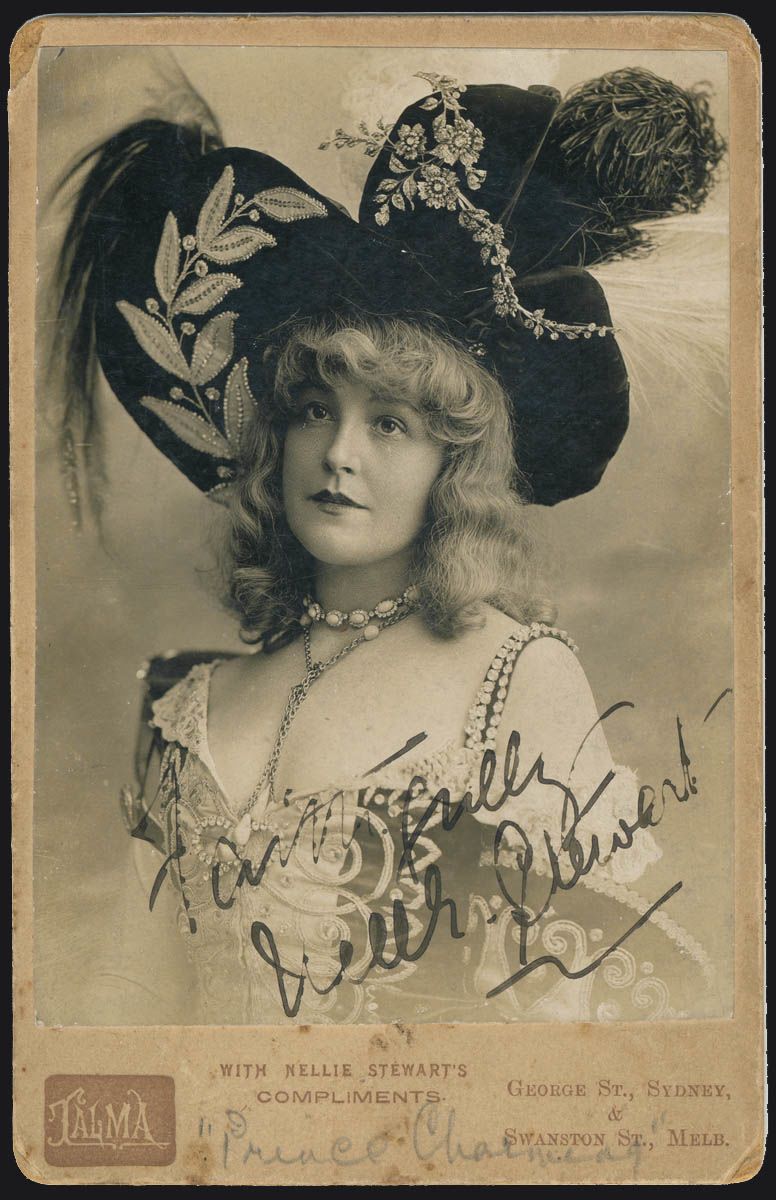
Nellie Stewart as Prince Charming in Cinderella, 1901
Nellie Stewart as Prince Charming in Cinderella, 1901
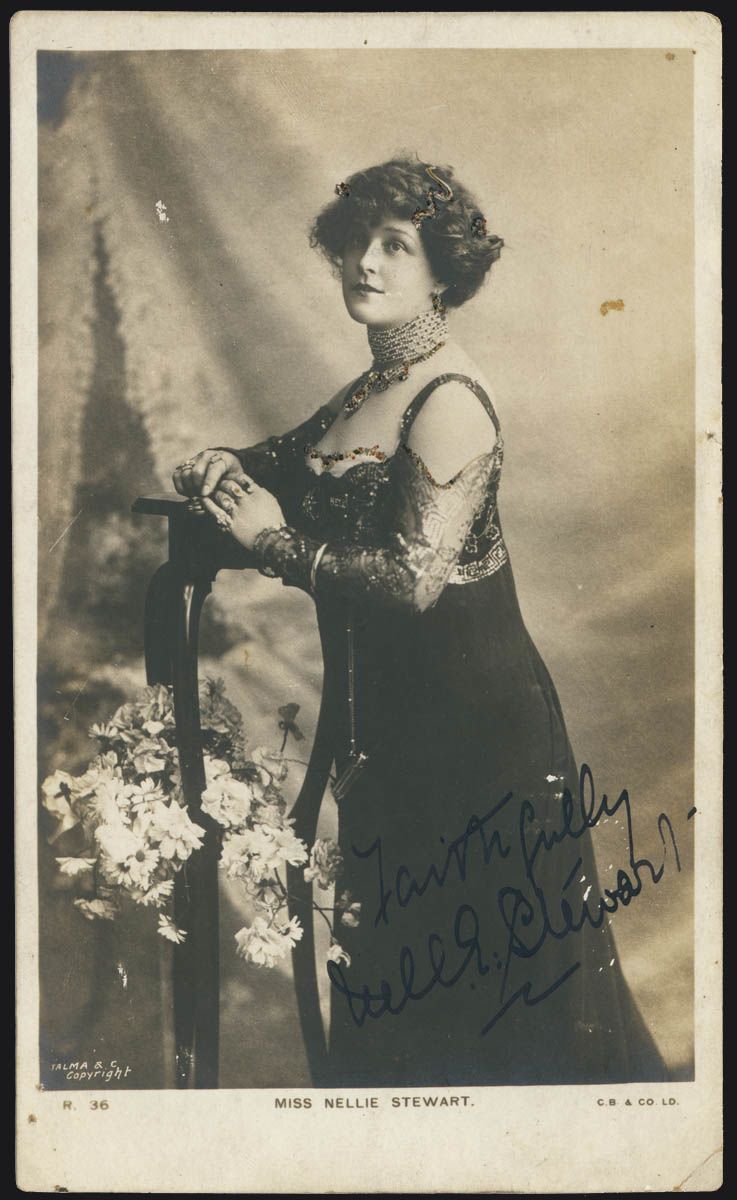
Nellie Stewart, 1901
Nellie Stewart, 1901
Nellie Stewart was one of the most photographed Australians of her day. Below are just some of the images held in the Australian Performing Arts Collection.
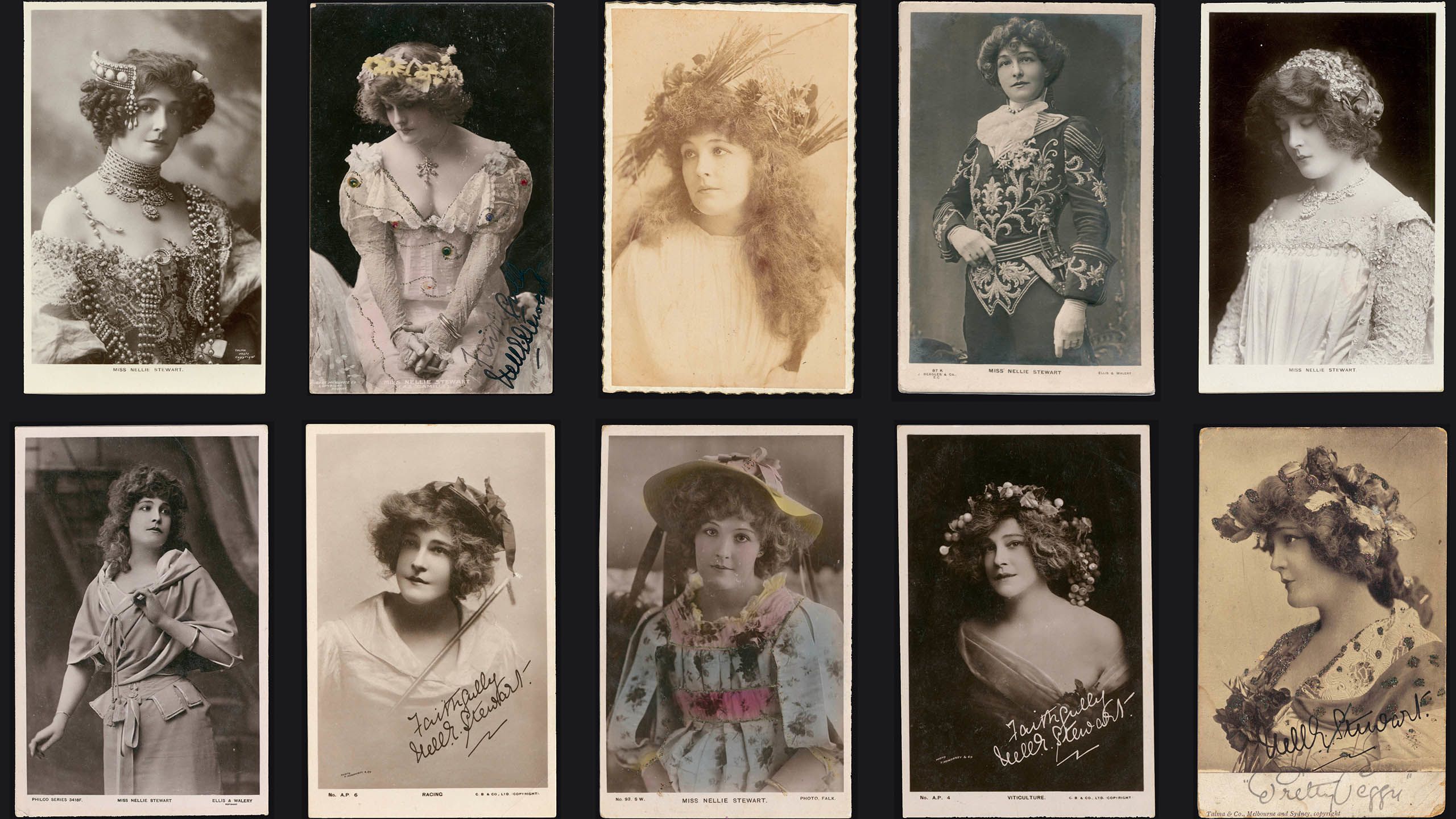
Credits
All photographs and objects are from the Australian Performing Arts Collection, Arts Centre Melbourne.
Nellie Stewart is quoted from her memoir My Life's Story, John Sands Ltd, Sydney, 1923.
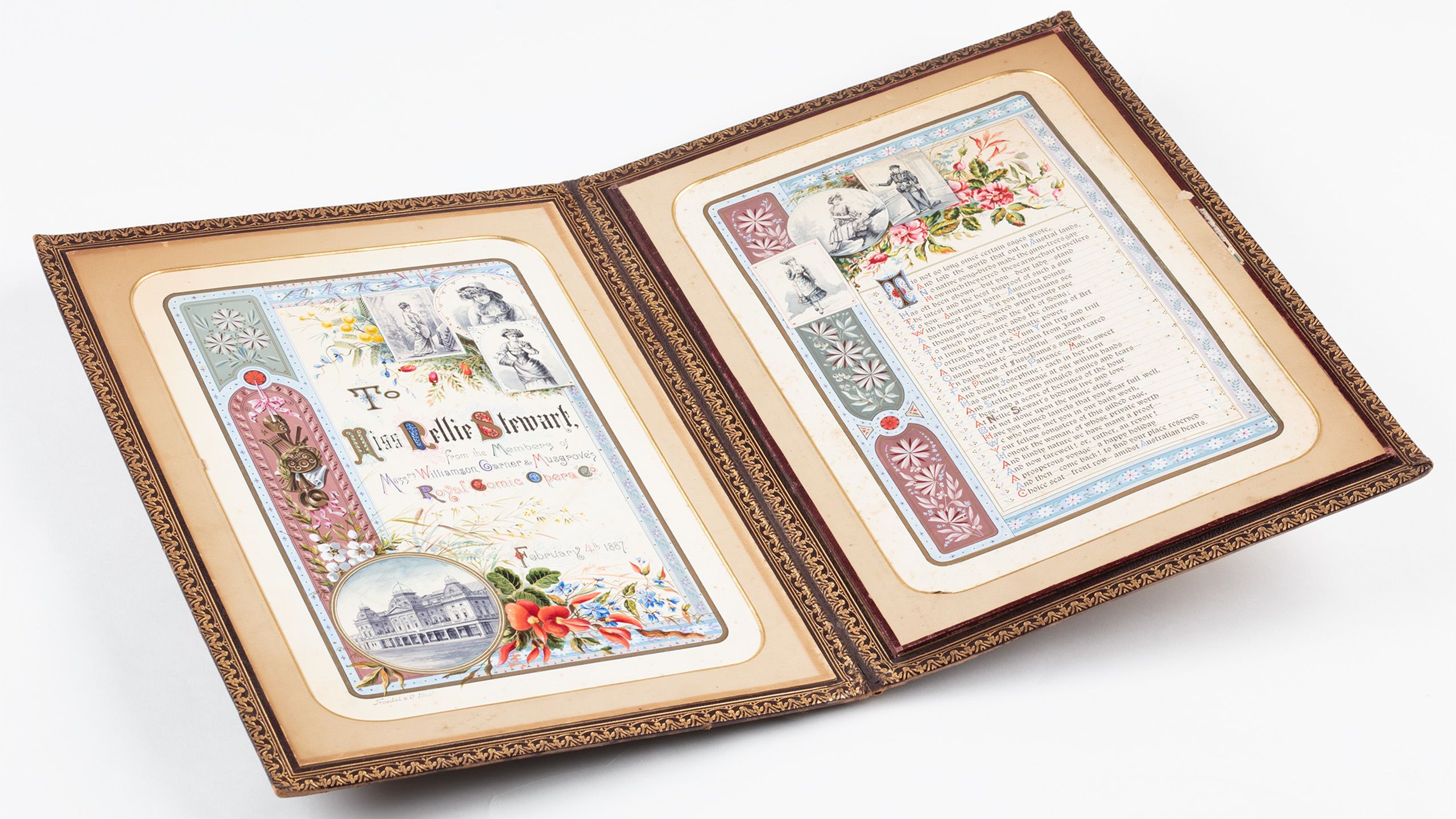
Bound tribute presented to Nellie Stewart by the Royal Comic Opera Company, Princess Theatre, Melbourne, 4 February 1887. Made by Troedel & Co. Illuminations. Gift of Michael Lynton, 1997.
Bound tribute presented to Nellie Stewart by the Royal Comic Opera Company, Princess Theatre, Melbourne, 4 February 1887. Made by Troedel & Co. Illuminations. Gift of Michael Lynton, 1997.
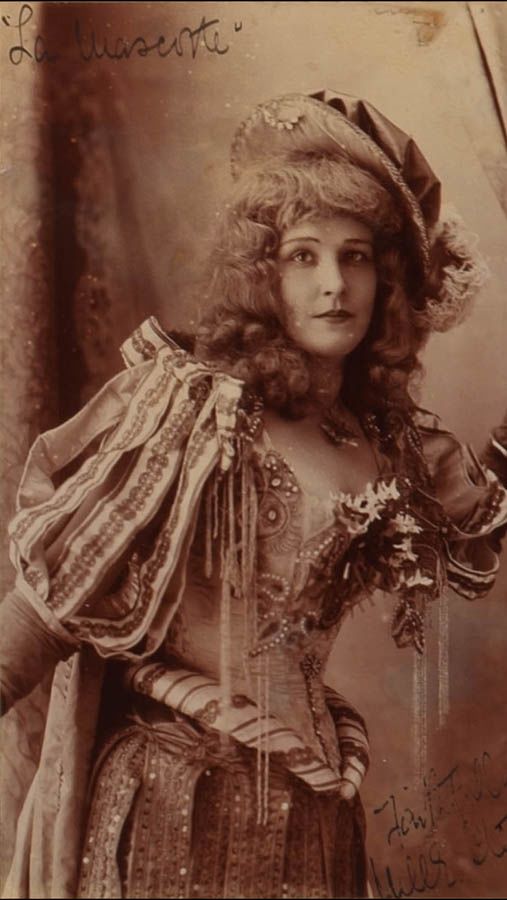
Nellie Stewart as Bettina in La Mascotte, 1890. Photographer unknown. Gift of Lady Viola Tait, 1979.
Nellie Stewart as Bettina in La Mascotte, 1890. Photographer unknown. Gift of Lady Viola Tait, 1979.

Nellie Stewart, 1881. Photograph by T. H. Boyd. Gift of Luciano Sita, 1989.
Nellie Stewart, 1881. Photograph by T. H. Boyd. Gift of Luciano Sita, 1989.

Nellie Stewart as Griolet in La Fille du Tambour-Major, 1881. Photographer unknown. Gift of Bette Pethebridge and Family, 1999.
Nellie Stewart as Griolet in La Fille du Tambour-Major, 1881. Photographer unknown. Gift of Bette Pethebridge and Family, 1999.

Brochure for the Royal Comic Opera Company, Abbott's Opera House, Auckland, New Zealand, 1884. Gift of Michael Lynton, 1998.
Brochure for the Royal Comic Opera Compnay, Abbott's Opera House, Auckland, New Zealand, 1884. Gift of Michael Lynton, 1998.
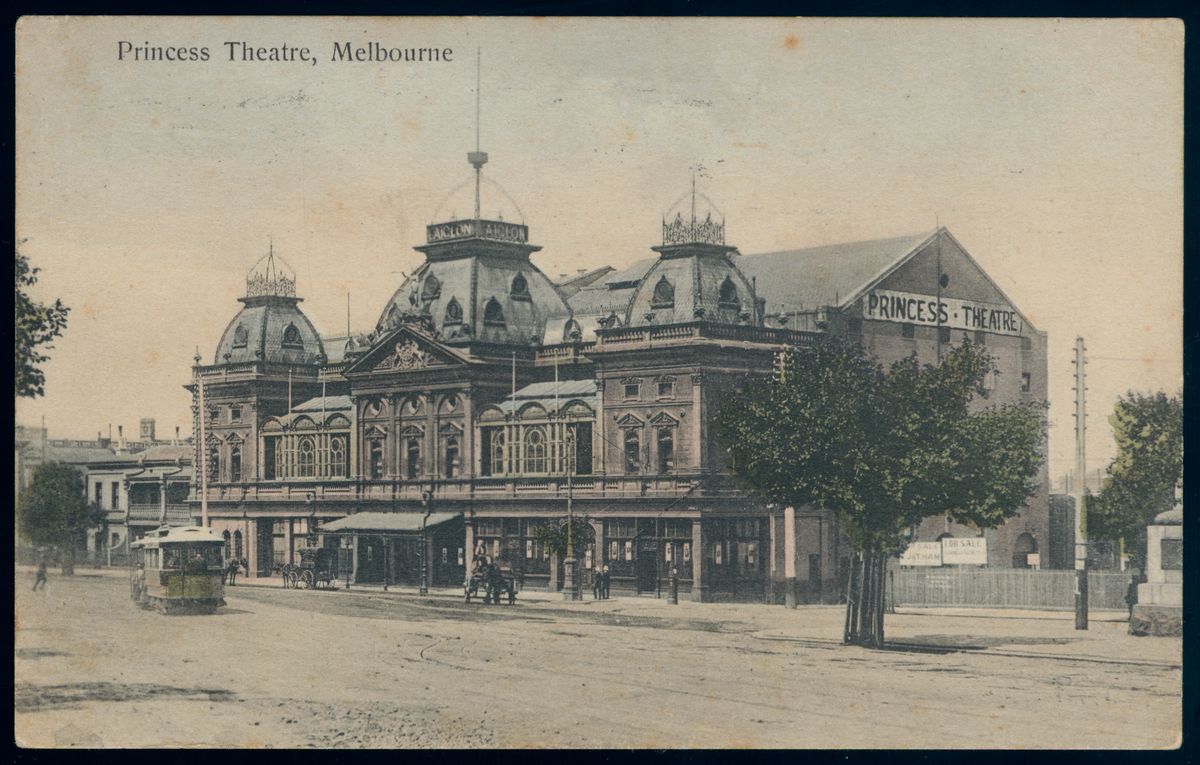
Postcard featuring the Princess Theatre, Melbourne, c.1907. Photographer unknown.
Postcard featuring the Princess Theatre, Melbourne, c.1907.

Nellie Stewart in The Mikado, 1885. Photograph by Tuttle & Co. Gift of Lorna Soloman, 1986.
Nellie Stewart in The Mikado, 1885. Photograph by Tuttle & Co. Gift of Lorna Soloman, 1986.

Interior of the Princess Theatre, Melbourne, c.1886. Engraving by William Thomas Smedley. Gift of Frank Van Straten AM, 2022.
Interior of the Princess Theatre, Melbourne, c.1886. Engraving by William Thomas Smedley. Gift of Frank Van Straten AM, 2022.

Portrait of George Musgrove from printed collage, c.1900. Photograph by Talma Studios. Gift of Lady Viola Tait, 1979.
Portrait of George Musgrove from printed collage, c.1900. Photograph by Talma Studios. Gift of Lady Viola Tait, 1979.

Leather frame owned by Nellie Stewart, containing photos of herself and George Musgrove, c.1895. Gift of Michael Lynton, 1998.
Leather frame owned by Nellie Stewart, containing photos of herself and George Musgrove, c.1895. Gift of Michael Lynton, 1998.

Pince-nez with metal case owned by George Musgrove, c.1905. Gift of Michael Lynton, 1998.
Pince-nez with metal case owned by George Musgrove, c.1905. Gift of Michael Lynton, 1998.

Nellie Stewart (fourth from left) and George Musgrove (right) at their home 'Mia-Mia' in England, 1899. Photographer unknown.
Nellie Stewart (fourth from left) and George Musgrove (right) at their home 'Mia-Mia' in England, 1899. Photographer unknown.

Nellie Stewart in the title role of Mam’zelle Nitouche, 1894. Photograph by Falk Studios. Gift of Bette Pethebridge and Family, 1999.
Nellie Stewart in the title role of Mam’zelle Nitouche, 1894. Photograph by Falk Studios. Gift of Bette Pethebridge and Family, 1999.

Nellie Stewart as Marguerite in Faust, 1888. Photographer unknown.
Nellie Stewart as Marguerite in Faust, 1888. Photographer unknown.

Nellie Stewart as Prince Charming in Cinderella, 1901. Photograph by Talma Studios. Gift of Bette Pethebridge and Family, 1999.
Nellie Stewart as Prince Charming in Cinderella, 1901. Photograph by Talma Studios. Gift of Bette Pethebridge and Family, 1999.

Nellie Stewart as Nell Gwynne in Sweet Nell of Old Drury, c.1907. Photographer unknown.
Nellie Stewart as Nell Gwynne in Sweet Nell of Old Drury, c.1907. Photographer unknown.

Nellie Stewart, 1901. Photograph by Talma Studios. Gift of Betty Pethebridge and Family, 1999.
Nellie Stewart, 1901. Photograph by Talma Studios. Gift of Betty Pethebridge and Family, 1999.

'Nellie Stewart' style bangle. Engraved: 'To Dulcie from Nellie Stewart Xmas 1930'. Gift of Mrs H. Cocks, 1979.
'Nellie Stewart' style bangle. Engraved: 'To Dulcie from Nellie Stewart Xmas 1930'. Gift of Mrs H. Cocks, 1979.

Postcards featuring Nellie Stewart, c.1891–1905. Transferred from the Dennis Wolanski Library, Sydney Opera House, 1997; Gift of Bette Pethebridge and Family, 1999; and Gift of Nonie Pendlebury, 1982.
Postcards featuring Nellie Stewart, c.1889–1905. Transferred from the Dennis Wolanski Library, Sydney Opera House, 1997; Gift of Bette Pethebridge and Family, 1999; Gift of Nonie Pendlebury, 1982 and Gift of Mrs W. G. Hide, 1979.

